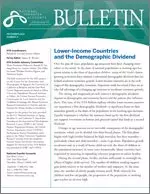Error message

Additional titles in the NTA Bulletin series Over the past 60 years, population age structures have been changing everywhere in the world. As the share of national populations at working ages has grown relative to the share of dependent children, many of the world's fastest-growing economies have enjoyed a substantial demographic dividend that has helped accelerate economic growth. Eventually, the share of the working-age population goes down, and the elderly portion of the population goes up. Improvements in life expectancy reinforce the effects of low fertility to produce populations that are much more concentrated at older ages. This stage of population aging can act as a brake on economic growth because the number of consumers is growing more quickly than the number of workers. Alternatively, if resources generated by the first demographic dividend are invested in physical capital and in children's health and education and if workers save and invest to provide for their own retirement costs rather than drawing on the resources of younger generations, then population aging may generate a second demographic dividend. That is, the processes of fertility decline and population aging can promote economic growth by raising the amount of physical and human capital per worker. Lower-income countries with large child populations will not achieve a demographic dividend until birth rates decline and age structures shift away from a pattern that is dominated by large numbers of children. Investment in the health and education of each child is also important to boost the productivity of future workers. In addition to high fertility, many lower-income countries face high unemployment or underemployment among young adults. Policies and programs that improve labor participation rates and labor income are critical, particularly for young workers who comprise large segments of these populations. And finally, it is not too soon to think about the economic consequences of population aging.
|
Additional titles in the NTA Bulletin series Over the past 60 years, population age structures have been changing everywhere in the world. As the share of national populations at working ages has grown relative to the share of dependent children, many of the world's fastest-growing economies have enjoyed a substantial demographic dividend that has helped accelerate economic growth. Eventually, the share of the working-age population goes down, and the elderly portion of the population goes up. Improvements in life expectancy reinforce the effects of low fertility to produce populations that are much more concentrated at older ages. This stage of population aging can act as a brake on economic growth because the number of consumers is growing more quickly than the number of workers. Alternatively, if resources generated by the first demographic dividend are invested in physical capital and in children's health and education and if workers save and invest to provide for their own retirement costs rather than drawing on the resources of younger generations, then population aging may generate a second demographic dividend. That is, the processes of fertility decline and population aging can promote economic growth by raising the amount of physical and human capital per worker. Lower-income countries with large child populations will not achieve a demographic dividend until birth rates decline and age structures shift away from a pattern that is dominated by large numbers of children. Investment in the health and education of each child is also important to boost the productivity of future workers. In addition to high fertility, many lower-income countries face high unemployment or underemployment among young adults. Policies and programs that improve labor participation rates and labor income are critical, particularly for young workers who comprise large segments of these populations. And finally, it is not too soon to think about the economic consequences of population aging.
|





